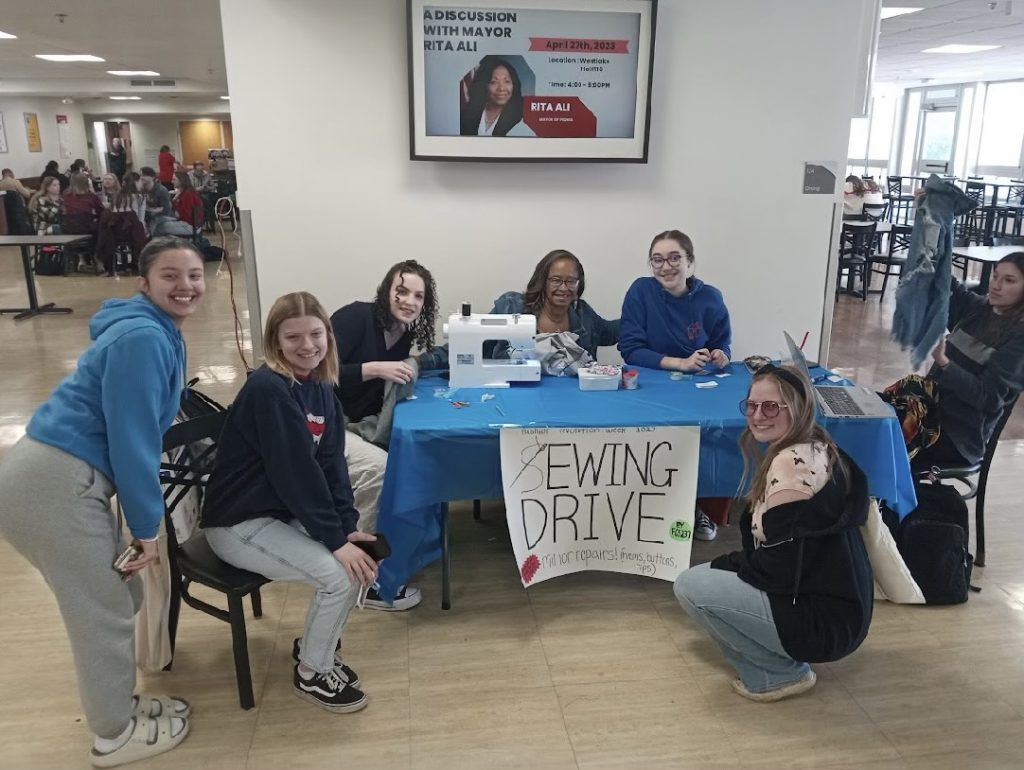Have you ever thought about ways you can be environmentally sustainable with your clothing? This week, Bradley’s Family Consumer Science 237 class put together five groups that demonstrated ways that you can re-use and revamp your clothes to produce less clothing waste.
Sustainability was shown around campus in honor of Fashion Revolution Week, a campaign that demonstrates seven days of action for the fashion activism movement. This campaign lasts from April 22-29 and was created in 2013 to spread awareness about the Rana Plaza tragedy.
This event occurred on April 24, 2013 when a garment factory in Bangladesh collapsed after a discovery of structural damage. According to cleanclothes.org, the tragedy resulted in the deaths of 1,134 workers and left thousands more injured.
Each group came up with an idea on how to demonstrate clothing sustainability and support fashion week. These groups consisted of a sewing drive, two tie dye events, an informational table about fashion pollution and a clothing drive.
The sewing drive was hosted on April 24 in the Michel Student Center and allowed anyone who needed their clothes to be mended to sign up and drop them off at the table for students to repair and return instead of throwing them away. These repairs included sewing on buttons, zippers, hems and rips.
“Repairing clothes instead of throwing them away, I think, can make a little bit less of a carbon footprint,” freshman public relations and advertising major Alyssa Barrera said. “Making clothes in general releases a lot of carbon emissions in the air which are toxic.”
Many students and faculty gathered in the student center to drop off their clothes, some even leaving baskets of clothes to be mended. Repairs didn’t take long and students got their clothing back soon after dropping them off.
“I think [the sewing drive] was very convenient,” junior biochemistry major Ashley Maguire said.
Maguire added that she’s satisfied with the repairs on a shirt she dropped off and will go back again if the event becomes annual.
An informational table about fashion pollution was also set up in the student center. This table included a guessing game and a slideshow with facts about working conditions and effects that the fashion industry has on our environment.
“We’re basically being informational while doing a guessing game about how to be sustainable, as well as the downfalls of the fashion industry,” freshman apparel production and merchandising Kedzie Rylie said. “We have a few questions that people can answer while informing them about research we’ve done.”
If someone answered the questions correctly, they could win a free Starbucks gift card or candy for their efforts.
According to the slideshow, garment workers are often paid under a dollar an hour while the salary for sanitation workers is incredibly thin. No healthcare is offered to employees, even with unsafe working conditions that can result in fatalities.
The table also provided information on greenwashing, which is when a company markets their brand as “green” rather than actually doing the work to make their products sustainable. Signs of greenwashing include lack of transparency, misleading claims and labels, terms like “energy efficient” and lack of facts to back up their sustainability.
The same day, a tie dye event was held on Olin Quad. Attendees were able to bring items like old shirts, socks, shorts and anything else they wanted dyed to the quad to give them a new look.
“Not a lot of people are aware of the troubles with the fashion industry,” sophomore psychology major Alexandra Loyo said. “Being sustainable is a great thing…A lot of people were glad to know about this information.”
There was also another similar tie dye event on April 26, the same day of a clothing drive held in the student center, which was hosted for local Peoria shelters and allowed anyone to donate one clothing item and take one clothing item.
“It’s a way to spread awareness in terms of fashion sustainability,” junior graphic design and sculpture major Rebecca Emert said. “With thrifting specifically, only about ten percent of what gets donated actually ends up on the floor for people to sell.”
Emert said that clothing swaps are a great way to find new styles through giving or swapping clothes and filling the gap that occurs when donated clothes aren’t being put out on store floors.
The clothing drive table was filled with different styles of clothes that could be swapped out for any item, creating a mini thrift store on Bradley’s campus.
This group highly recommended enrolling in FCS 237, as it has been an eye-opening experience for them to the world of fashion and the pollution that can occur as a result.





